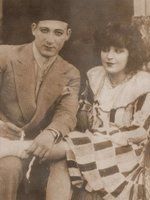Bamba Kashar (1860 - 1930) بمبة كشر
Biography
An Egyptian dancer, born in 1860 into a wealthy family. Her paternal grandfather is Mostafa Kashar, an Egyptian notable, and her father Ahmed Mostafa is a famous Quran reciter. Her father died when she was fourteen years old, and her mother married Khedive Tewfik's personal Quran...Read more reciter, which prompted Bamba and her sisters to leave their mother and move to another residence next to a well-known Turkish dancer at the time who discovered Bamba's dancing talent, and took her to all her parties. Bamba became famous for being the dancer of kings and sultans. There was a strong rivalry between her and famous dancer Chafika el Keptia, who used to dance with a candleholder on her head, so she started dancing with a tray with cups filled with gold on her head. She also used a horse-drawn carriage for transportation, and in front of her a number of men ran to make way for the carriage. She was married six times and her second marriage was to the well-known vocalist at the time Sayed al-Safti. She appeared in silent films toward the end of her life, such as Laila (1927) and The Nile's Girl (1929). She continued to practice dancing until she reached the age of seventy. She died in 1930.
-
- Nationality:
- Egypt
-
- Died on:
- 11 February 1930
Watch Online (Sponsored By Yango Play)
-
-
- Siko Siko
- 2025 - Movie
-
-
- One Last Sin
- 2025 - Series
-
-
- 2 Qahwa
- 2025 - Series
-
-
- Rocky El Ghalaba
- 2025 - Movie
-
-
- Ward w Shokolata
- 2025 - Series
-
-
- Al Shater
- 2025 - Movie
Known for
(According to views)
More details
An Egyptian dancer, born in 1860 into a wealthy family. Her paternal grandfather is Mostafa Kashar, an Egyptian notable, and her father Ahmed Mostafa is a famous Quran reciter. Her...Read more father died when she was fourteen years old, and her mother married Khedive Tewfik's personal Quran reciter, which prompted Bamba and her sisters to leave their mother and move to another residence next to a well-known Turkish dancer at the time who discovered Bamba's dancing talent, and took her to all her parties. Bamba became famous for being the dancer of kings and sultans. There was a strong rivalry between her and famous dancer Chafika el Keptia, who used to dance with a candleholder on her head, so she started dancing with a tray with cups filled with gold on her head. She also used a horse-drawn carriage for transportation, and in front of her a number of men ran to make way for the carriage. She was married six times and her second marriage was to the well-known vocalist at the time Sayed al-Safti. She appeared in silent films toward the end of her life, such as Laila (1927) and The Nile's Girl (1929). She continued to practice dancing until she reached the age of seventy. She died in 1930.
- Nationality:
- Egypt
- Died on:
- 11 February 1930























